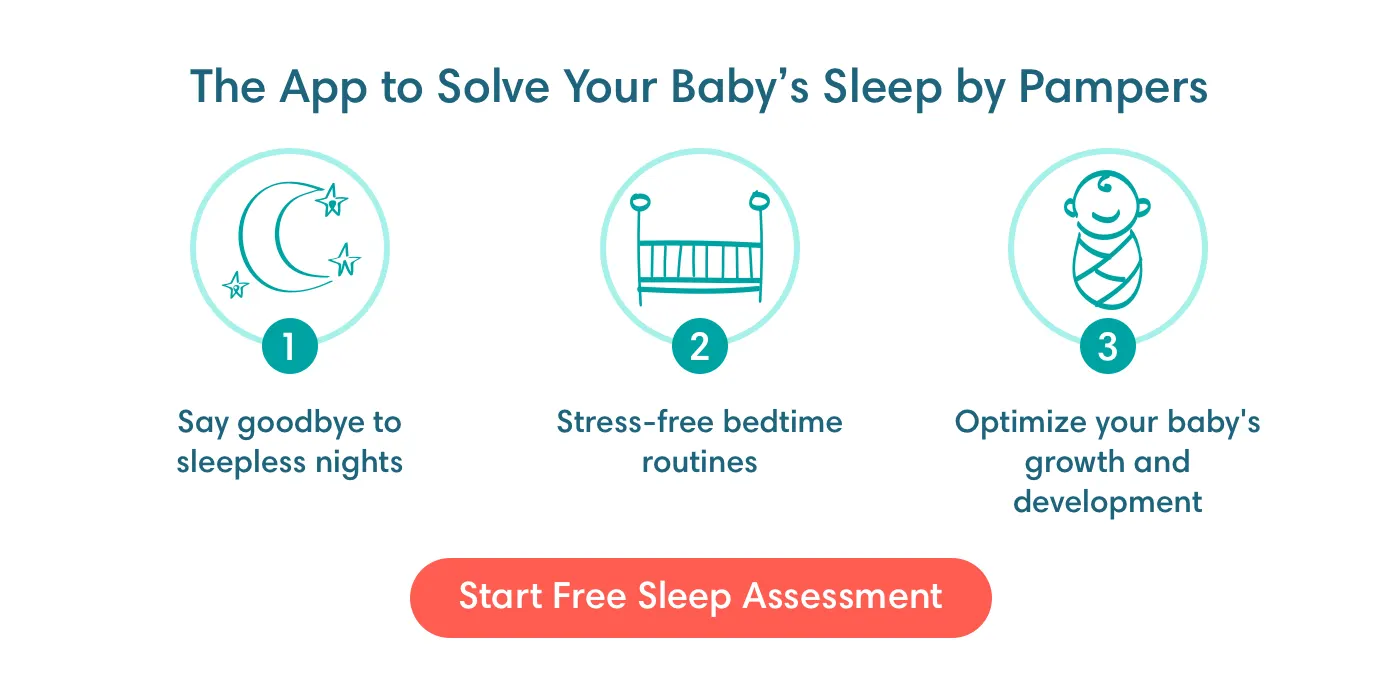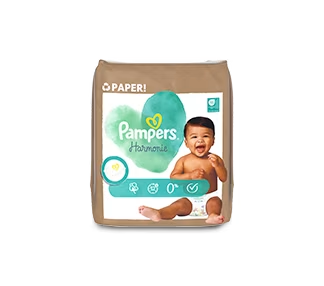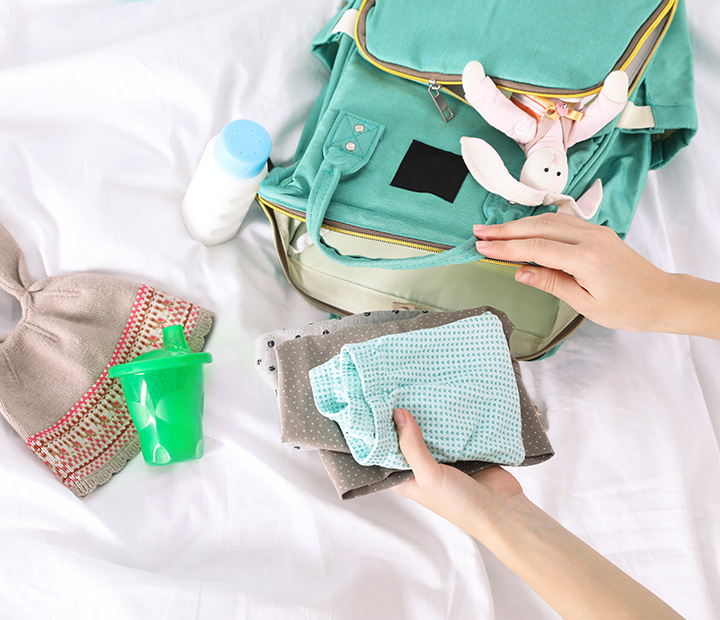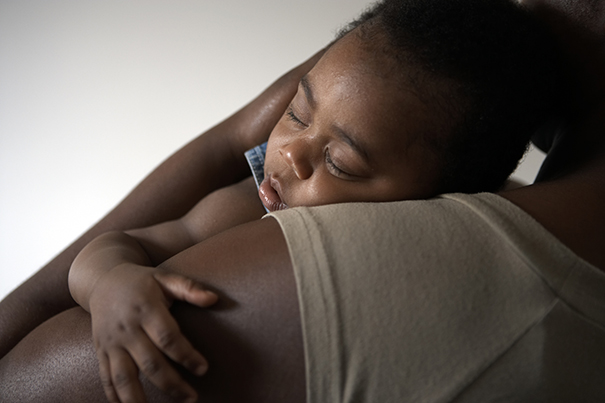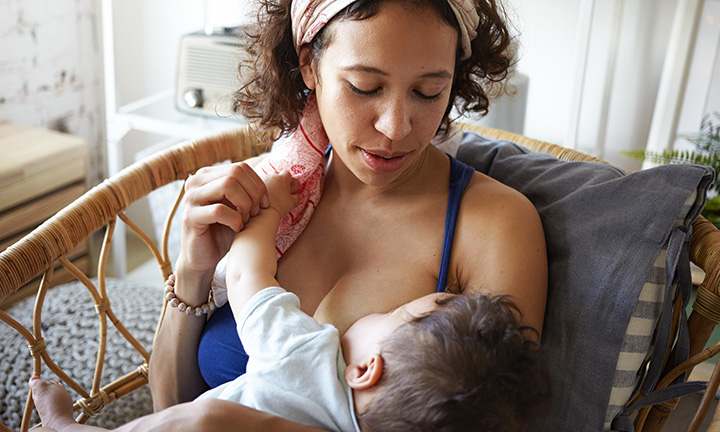
Baby Feeding Schedule: What to Expect in the First Year
5 min readUpdated March 20, 2025
5 min readUpdated March 20, 2025
Wondering what a good baby feeding schedule looks like for your little one? You’re not alone. Many parents find themselves unsure about how much breastmilk or formula their baby needs, especially in those early weeks. The reassuring news is that there are plenty of signs to help you know if your little one is getting enough nourishment. Read on to learn more and explore our helpful baby feeding schedule by age.
Baby Feeding Chart
It’s recommended to feed your newborn on demand, following their cues – like restlessness, rooting (a reflex of turning their head and opening their mouth in search of food) or sucking on their fists – to guide how often they need to be fed. Most babies will naturally settle into a baby feeding schedule of around 8 to 12 feeds every 24 hours, although some may want to feed more frequently, especially during growth spurts.
Use our newborn baby feeding schedule chart below for guidance, however, always pay close attention to your little one’s hunger signals to ensure they’re getting enough nourishment.
How Much Should a Newborn Eat?
It’s impossible to overfeed a breastfed baby, so feel free to breastfeed whenever your little one shows signs of hunger or when you need to relieve fullness. Breastfeeding may also be a comforting time for both you and your little one.
For formula-fed babies, experts recommend offering 150-200 ml of formula per kilogram of body weight each day. This continues until around 6 months, when you can gradually introduce solid foods alongside formula. However, feeding patterns may vary daily, so it’s best to watch for hunger cues and feed on demand.
Whether you’re breastfeeding or formula feeding, the best way to know if your baby is getting enough nourishment is by tracking wet and dirty nappies. By the end of the first week, babies who are feeding well typically have at least six wet nappies a day. Healthy weight gain is another positive sign that your little one is receiving the right amount of nutrition.
Your GP will be tracking your little one’s growth using baby weight and growth charts at your regular health and development reviews, but you can talk to your little one’s GP anytime if you have any concerns or questions about your baby’s growth.
How Much Should a 3-Month-Old Eat?
As your little one reaches 3 months of age, you might notice they’re becoming more active and starting to sleep for longer stretches at night.
Breastfed Baby
This usually means they will begin to breastfeed less often and may sleep for longer stretches at night. This, in turn, leads to fewer (but bigger) feeds in every 24-hour period. Every baby is different, so your 3-month-old baby's feeding schedule may vary based on your little one’s needs.
Formula-Fed Baby
You may need to increase the amount of formula you feed your little one, following the general guidance of 150-200 ml of formula per kilogram of body weight per day.
Now that you and your little one have settled into a routine, it might seem difficult to make changes, but as your little one grows, you’ll need to adjust to their changing needs. If your GP sees that your baby is gaining weight and growing at a regular pace, then your child is probably getting the right amount of nutrition. Check-in with your little one’s GP if you’re concerned that your little one may not be getting enough to eat.
How Much Should a 6-Month-Old Eat?
At 6 months old, experts recommend introducing solid foods alongside breast milk or formula, which will still provide most of the energy and nutrients your little one needs.
Keep in mind that solids are only a supplement at this stage. The main goal is to help your little one get used to new textures and flavours. Letting your baby explore a variety of foods alongside breast milk or formula lays a solid foundation for healthy eating habits later in life.
Night-time feeds might not be needed anymore at 6 months old, but every baby is unique. Speak to your little one’s GP about whether it’s time to cut down on night-time feeds and what you can do to encourage the process.
How Much Should a 7 to 9-Month-Old Eat?
Between 7 and 9 months old, your baby will continue to rely on breast milk or formula for essential nutrients, needing around 600ml per day. Alongside this, you may begin offering three meals a day – breakfast, lunch and a mid-afternoon meal – while adjusting feeds based on your little one’s needs.
Introduce a variety of solid foods from all the main food groups, including vegetables, fruits, starchy foods, protein-rich options like meat, fish, or beans, and full-fat dairy. As your baby becomes more comfortable with solids, you may begin adding new textures like purees, lumpier mashed foods and finger foods.
Your baby’s feeding schedule will continue to evolve by age so let their appetite guide you and don’t worry if their intake varies from day to day.
How Much Should a 10 to 12-Month-Old Eat?
At 10 to 12 months old, exploring new textures becomes an exciting part of your little one’s meals. Your baby may start to self-feed with finger foods like chopped bananas or small pieces of pasta, gaining more independence at mealtimes.
Breast milk or formula will still provide important nutrition and should remain your baby’s main drink until they turn one. If you’re breastfeeding, continue to feed on demand – your little one will naturally adjust their intake based on how much solid food they’re eating. For formula-fed babies, a rough guide suggests around 400ml of first infant formula per day at this stage of weaning. First infant formula refers to the standard milk suitable from birth to 12 months, and the amount refers to your baby’s total intake throughout the day, given alongside meals or in between.
How Often Do Newborns Eat?
In the first few days, your little one will need to feed at least 8 to 12 times every 24 hours. Feeding on demand is recommended – watch for signs like restlessness, sucking on their fists or rooting. As your baby grows, their feeding schedule may become more predictable, but it’s important to continue feeding based on their hunger cues. By the end of the first week, they’ll likely have settled into a more regular pattern.
How Often Does a 3-Month-Old Eat?
Breastfed Baby
At 3 months, your baby is likely becoming more active and may breastfeed less often, with longer stretches of sleep at night. You might find they feed around 5 to 6 times a day, roughly every 3 to 4 hours, but this may vary based on your little one’s needs.
Formula-Fed Baby
Formula-fed babies at this stage may also feed around 6 to 8 times a day. Continue to feed on demand, as your baby’s appetite may change from day to day.
How Often Does a 6-Month-Old Eat?
At 6 months old, your little one will still need regular feeds of breast milk or formula, alongside the introduction of solid foods. Most babies continue to have around five feeds a day, with breast milk or formula providing most of their nutrition.
Night feeds may start to reduce around this time, but every baby is different. Speak to your little one’s GP if you’re unsure whether it’s time to cut down on night-time feeds or how to approach the process.
How Often Does a 7 to 9-Month-Old Eat?
Between 7 and 9 months old, your little one may begin to have around 4 feeds a day as solid foods become a more significant part of their diet. While breast milk or formula will still provide important nutrients, your baby’s growing body will rely more on solid foods for energy and development.
There’s no set time to fully wean off breast milk or formula – follow your baby’s cues and appetite. Consult your little one’s GP if you have any concerns or questions about how much your little one should be eating.
How Often Does a 10 to 12-Month-Old Eat?
At 10 to 12 months old, your baby will likely be eating three meals a day alongside breast milk or formula, which should still be their main drink until they turn one.
Finger foods can be a fun and important part of developing independent eating habits. Make sure food is cut into small, manageable pieces to reduce the risk of choking. Avoid offering foods like whole grapes, whole nuts or popcorn, which may pose choking hazards. With time and practice, your little one will become more confident in self-feeding.
When Do Babies Start Eating Baby Food?
Most babies are ready to start solid foods at around 6 months old, while continuing with breast milk or first infant formula, which should remain their main source of nutrition.
Signs that your baby may be ready to start solids include being able to sit up with support, having good head and neck control and showing an interest in food – such as reaching for items on your plate. Experts recommend beginning with single-ingredient, iron-rich foods like puréed vegetables, mashed fruits and iron-fortified baby cereals.
It’s important to introduce one new food at a time, leaving a few days in between to watch for any allergic reactions. Signs of an allergy may include a rash, swelling of the face, lips or eyes, vomiting, or diarrhoea. If you notice any of these, seek medical advice promptly.
This gradual approach helps your little one get used to different tastes and textures while developing self-feeding skills. If you have any concerns about the weaning process, consult your baby’s GP for guidance.
FAQS AT A GLANCE
In the first few weeks, your baby will need to be be fed at least 8 to 12 times every 24 hours. Experts recommend feeding your baby on demand by watching for hunger cues, such as restlessness, sucking on fists or fingers, murmuring sounds or rooting.
The Bottom Line
As your baby grows, their feeding needs and appetite will change. Recognising hunger and fullness cues helps ensure they’re getting the right nutrition. When introducing solids, offering a variety of textures and flavours encourages healthy eating habits from the start.
Tracking wet nappies and monitoring your little one’s growth will reassure you they’re feeding well. Your baby’s GP can also provide personalised advice if you have any concerns.
Keeping your baby’s feeding schedule on track allows you to focus on all the exciting milestones ahead. By downloading the Pampers Rewards App, you can save and earn exclusive rewards with each Pampers purchase you make along the way.
How we wrote this article
The information in this article is based on the expert advice found in trusted medical and government sources, such as the National Health Service (NHS). The content on this page should not replace professional medical advice. Always consult medical professionals for full diagnosis and treatment.
- NHS. 'The first few days'.
- Derbyshire Healthcare NHS Foundation Trust. 'Formula feeding'.
- NHS. 'Formula milk questions'.
- Great Ormond Street Hospital. 'Breastfeeding and expressing milk'.
- NHS. 'Latching on'.
- Wirral Community Health and Care NHS Foundation Trust. 'Safer sleep for 3-6 months'.
- NHS. 'Baby's first solid foods'.
- NHS. 'Helping your baby to sleep'.
- NHS. 'Ready or not'.
- NHS. 'What to feed your baby 7-9 months'.
- NHS. 'What to feed young children'.
- NHS. '12 months'.
- NHS. 'How to stop breastfeeding'.
- Derbyshire Healthcare NHS Foundation Trust. 'Breastfeeding guide Derby City Infant Feeding Team'.
- NHS. '10 to 12 months'.
- NHS. 'How to start weaning your baby'.
- NHS. 'What to feed your baby 7 to 9 months'.
